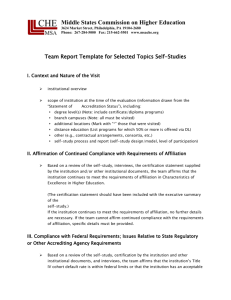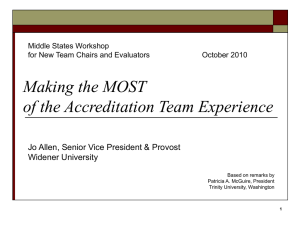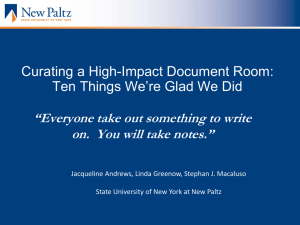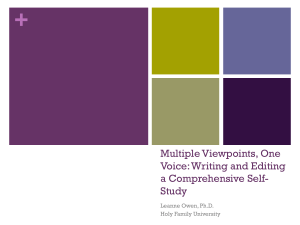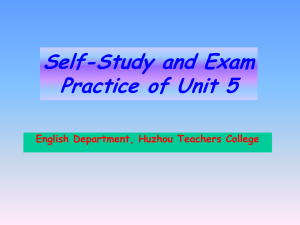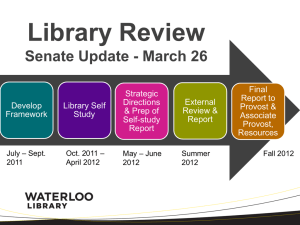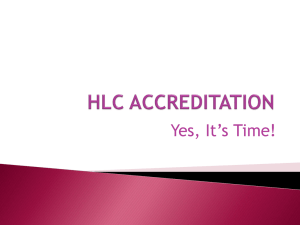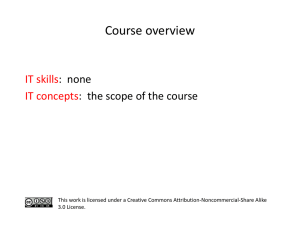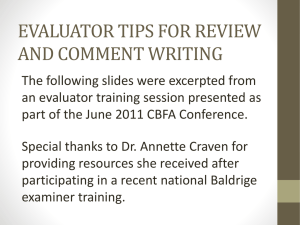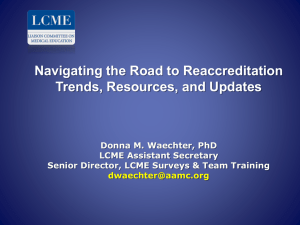ACPHA Guide for Team Chairs Conducting a Site Visit Presentation
advertisement
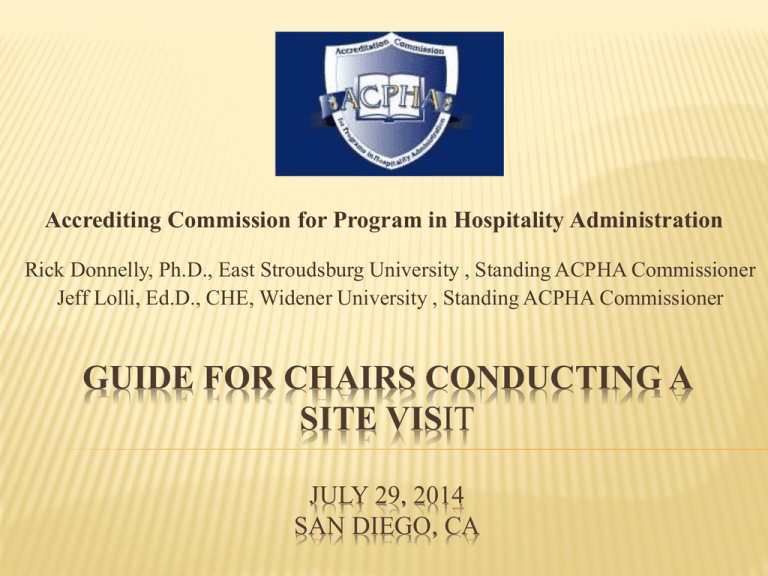
Accrediting Commission for Program in Hospitality Administration Rick Donnelly, Ph.D., East Stroudsburg University , Standing ACPHA Commissioner Jeff Lolli, Ed.D., CHE, Widener University , Standing ACPHA Commissioner GUIDE FOR CHAIRS CONDUCTING A SITE VISIT JULY 29, 2014 SAN DIEGO, CA SESSION OVERVIEW Introduction Chairperson Responsibilities Before the Visit During the Visit After the Visit OPENING Host and Attendee Introductions How many site visits have you been a team member for in the past 3 years? Have you chaired a previous visit? When and where did you go? What was your experience like? Did you feel well prepared? Did you feel the chair was well prepared? INTRODUCTION The interaction between the Commission on Accreditation and a hospitality management program can be summarized as follows: The program looks at itself and speaks to the Commission through its self-study document A team of experienced peers, appointed by the Commission, appraises and advises the program, through an evaluation team report The program replies to the team report in a written response addressed to the Commission INTRODUCTION The interaction between the Commission on Accreditation and a hospitality management program can be summarized as follows: The Commission, after considering the information derived from the preceding three steps, determines accreditation status. The Commission alone makes accreditation decisions The program, as part of its ongoing evaluation and planning process, continues to consider and act on the results of its own self-study and the advice it has received INTRODUCTION The team visit is important for several reasons: Provides an opportunity to verify the information submitted in the self-study report Team members can derive additional data clarifying the written report which enables them to probe more deeply on some issues. Inquire about areas in programmatic life not adequately covered in the self-study INTRODUCTION The team visit is important for several reasons: Stimulate growth and development in the program The interchange of information and viewpoints and the raising of important questions and issues in interviews should inspire insights and encouragement in reassessing what has been done and considers ideas that may enhance the program in the future BEFORE THE VISIT Chairperson Key Responsibilities Introductions to Program Administrator/confirmation Initial Team Contact Coordinate team member travel and lodging Coordinate itinerary for accreditation visit Review and assign sections to team members Request any additional information from the Program Coordinate workroom location, documents and technology Send team report template and final itinerary BEFORE THE VISIT Initial Communication with Program Contact Program Administrator/Discuss procedures and details Discuss team member lodging, travel and meals – minimize cost to each team member Discuss traveling to and from the lodging site and campus Discuss work room location, supplies, support documents Discuss team member itinerary for accreditation visit with Program Administrator Discuss any concerns with ACPHA BEFORE THE VISIT Initial Communication with Team Contact team member to discuss lodging, travel and meals Discuss what documentation or receipts are needed to ensure timely reimbursement Analyze team member experience, training, and assign sections Discuss itinerary for accreditation visit with team Discuss team member concerns and Chairperson expectations BEFORE THE VISIT Review of the Self-Study and Supporting Documentation The Self-Study Report should provide a comprehensive description, and a thorough in depth assessment of all aspects of the program. Nine total sections with 42 total standards: if there is a discrepancy, or the report is inadequate, contact ACPHA immediately. BEFORE THE VISIT The Self-Study If your review and study suggests the need for additional or clarifying information that would be helpful to the team, you should communicate this to the program administrator. It is the team chairperson's responsibility to convey this request to the program or to the Commission office as soon as possible, so the material can be available for the team's review, prior to the accreditation visit. BEFORE THE VISIT The Self-Study During the visit, there is no time to write a full report without a draft. It is extremely helpful if each team member begins to draft their responses to the standards in their assigned sections prior to the actual site visit The chair should provide the team with a template for preparing the report Responses should be based on the information available in the self-study and other supporting documentation Gathering additional information during the site visit is necessary to support your initial analysis BEFORE THE VISIT The Self-Study As you study it, prepare a checklist for your use during the visit. Here are some guiding questions: What else do you need to know about the program? At what point does the document need further clarification or interpretation? Are there inconsistencies within the document that will need to be explored? What are the apparent strengths and weaknesses of the program? Does the documented evidence provided substantiate the program’s claim in meeting the ACPHA Standards. Who are the people you will wish to interview? BEFORE THE VISIT The ACPHA Standards found in the Self-Study Explained Sections I. (Review Handout): Mission and Outcomes: 3 Standards II. Administration and Governance: 3 Standards III. Planning: 4 Standards IV. Assurance of Student Learning: 4 Standards V. Curriculum: 5 Standards VI. Instructional Resources: 10 Standards VII. Student Support Services: 7 Standards VIII. Physical and Learning Resources: 4 Standards IX. Financial Resources: 2 Standards DURING THE VISIT Initial on-site team meeting Discuss process, strategy and anticipated timetable Finalize each member’s responsibilities, and confirm procedures Program meet and greet Purpose - it sets the tone for individual interviews and discussions DURING THE VISIT Interviews with Administration Initial meetings- avoid discussions related to any findings based on preliminary document review Provide an opportunity to answer questions about ACPHA accreditation process Should be very collegial Interviews with constituents Faulty and staff Students Advisory board Alumni Support Staff throughout the university DURING THE VISIT Data collection and review Purpose-verify information reported in the Self-Study Meetings with current, former students and advisory board members Industry supervisors and alumni will enrich data Analysis of supporting documents i.e., degree plans, assessment plans, marketing and strategic plans, evidence of student performance, instruments used in data collection, relevant material not included in the Self-Study, meeting minutes, etc. DURING THE VISIT Team conferencing Pool resources and information Clarify Report / Team Consensus The Evaluation Report Follow Evaluation Report format Developing assigned sections with Chairperson guidance Draft Report (End of Day 2)- complete before departing Check report thoroughly for spelling, grammar, and formatting Program Strengths/ Weakness DURING THE VISIT The Evaluation Report (continued) Flow of the Report Identify full Standard Team response to Standards Standard is met- Strengths Standard is not met- Concern- RecommendationsSuggestions Consistent verbiage and format is important-Language shall not be prescriptive DURING THE VISIT The Exit Interview Content and tone of the report-collegial and helpful No statements should be made about the determination of accreditation status for the program (it is up to the Commission) Read full standard Identify which have been met and strengths if possible Identify which have NOT been met, Identify Concern(s) and Recommendation(s) Clarify as much as possible Interactive reading of report DURING THE VISIT Management of Team Expectations with respect to professionalism include attire and attitude Maintain high ethical and professional standards Avoid making comparisons with other programs Adhere to schedule Team should not socialize with Program during visit If Program wishes to do so after the exit interview, that is acceptable DURING THE VISIT Management of the Process role of the Chairperson is to plan the Team’s work Encourage team discussion-Note areas during interviews for clarification Keep members on task-discuss purpose of meetings (class meeting) Chair might take the lead in any particular meeting or assist team with follow-up Key AFTER THE VISIT Preparation of the Evaluation Report Send the final report electronically to team members immediately for review and corrections Chairperson returns report to program in 3-5 days to review for factual errors Tailor introduction to the program Identify what the program and faculty do well Reference the program self-study in the report Do NOT be prescriptive or shame individuals AFTER THE VISIT Preparation of Evaluation Report(continued) It is the responsibility of the Chairperson to submit a well organized final professional document to ACPHA Write Cover letter Instructions for the Program’s response to ACPHA Report Format (Appendix A) Chairperson sends the Cover Letter and Final Evaluation Report electronically to: 1) Program Administrator; 2) Team Members, and 3) ACPHA Office AFTER THE VISIT Commission Follow-up Commission meets twice annually to review reports Two Commissioners are assigned to review a program’s documents Primary and secondary Readers review Self-Study Report Available supporting documents –electronically Response to the Visiting Team Evaluation Report Program - Post Visit Response Report Commission Decision CONCLUSION Thank you for your time and commitment to attend this training. Open Discussion and Questions
